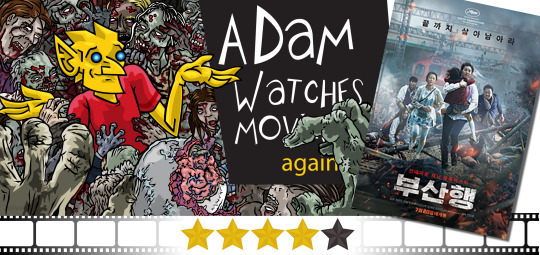#Haney Jia
Explore tagged Tumblr posts
Text
Train to Busan (2016)

Train to Busan makes great use of the familiar elements of a zombie movie by centering its plot on a single location and injecting societal commentary into its plot. While this 2016 horror film does not reinvent the wheel, what it does, it does well.
Seo Seok-woo (Gong Yoo), the divorced, workaholic absentee father of Su-an (Kim Su-an), agrees to bring his daughter to Busan so she can visit her mother. Onboard the train, a young woman suddenly bites one of the attendants. Soon, an infectious disease has reduced most of the passengers to gnashing ghouls. Those who remain must work together to survive.
After introducing Seok-woo and Su-an at their home, nearly all of the story takes place inside the titular train to Busan. We get a couple of stops along the way but these are at a train station and at a terminal, which are extensions of the train itself. On top of the usual fears of having to face possessed loved ones and rampant infection, we also deal with claustrophobia. The space inside the train is already small and it keeps getting smaller. When someone becomes infected, everyone rushes to the next compartment and blocks the entrance. The safe space has shrunk. Sometimes, people are forced to hide in the tiny bathrooms, holding the door shut as best they can while fingernails scrape the other side. The limited space and ressources requires ingenuity - both from the characters and the filmmakers. This is one of those movies where you can tell writer Park Joo-suk sat down and wrote every aspect of the train he could use. Tunnels, the bathrooms, luggage, doors, passengers, etc. You feel a certain satisfaction whenever he ticks off one of these boxes - you were just wondering how the characters would deal with X. They need to use their wits to survive and you’re glad to see that they’re all pretty sharp.
You can also tell care was put in the writing by the number of well-rounded characters. Not everyone gets equal amounts of screentime but you get to know many passengers. They’re not just bodies waiting to get infected. There’s character development and growth. You understand what makes these people tick. This is also where the movie injects some commentary about our society (or Korea’s, I guess). If there’s an antagonist - besides the zombies - it’s a rich businessman called Yon-suk (Kim Eui-sung). You can see he might represent Seok-woo's future. Both are well-paid tie-wearing men who are all about their jobs, and nothing else. Both are disconnected from the world, as evidenced by their treatment of the other passengers. Unlike the altruistic blue-collar Yoon Sang-hwa (Ma Dong-seok), they hesitate to help anyone. With his relation to his daughter already strained, you can picture Seok-woo becoming exactly like the older man - and you hate that guy. He’s a worm but he’s also got power. The attendants and the train’s captain all turn to him - the rich guy - rather than the common people when a crisis arises. They don't realize he only cares about himself. Everyone is scared but his fear threatens to doom everyone. We’re used to this idea that “the worst monsters are the people” in zombie movies so it doesn’t feel out of place, and it gives you something to think about too.
The picture maintains a steady level of suspense throughout. Whenever you get a reprieve, it’s either to set up somethig even bigger or allow you to get to know the characters. Now that you care about them that much more, the stakes feel bigger than before. The body count grows, the number of people shrinks, those who remain you’re even more determined to see survive. Best of all, you’re not sure who will make will live and who won't.
Train To Busan is one of the better zombie films in recent years. It’s got the right amount of gore and suspense to keep horror fanatics happy and it shows restraint when needed to make it nice and accessible to the rest too. (Original Korean with English subtitles, April 2, 2021)

#Train to Busan#movies#films#movie reviews#film reviews#Yeon Sang-ho#Park Joo-suk#Gong Yoo#Jung Yu-mi#Ma Dong-seok#Kim Su-an#Choi Woo-shik#Ahn So-hee#Kim Eui-sung#Haney Jia#2016 movies#2016 films
3 notes
·
View notes
Text
doing things.
OV got the New Yorker profile treatment. The perfect writer for this is of course Jia Tolentino, who can deploy her critical eye with a perfect balance of skepticism and receptivity.
Full disclosure: I love wearing OV. My fundamental problem with them is my fundamental problem with all pseudo-self empowerment branding: it’s all performative to sell you something. Do I love compression leggings? Yes. Do I not have instagram on my phone and feel better for it? ONE THOUSAND TIMES YES. Do I need a $95 Rec Kit? No. Will I still buy the rec kit even though I’m not instagramming myself in it? Probably yes (especially since I find out about grad schools on Friday, hashtag pray for my bank account).
Last night I was re-watching an old episode of the West Wing, in which Leo refers the von Bismarck quote, “There are two things in the world you never want to let people see how you make 'em: laws and sausages.” I always feel like agreeing to be profiled is a gamble, because I’m not sure I want to see how my OV gets made. Tolentino’s anecdote about the yoga class at the end of the article is a perfect encapsulation of a system that correlates virtue with consumption and efficiency, and how we not only tell ourselves narratives of self-improvement and self-awareness, but are sold those narratives to buy more and do more.
So, as with everything, I’m in the charcoal and/or dove grey area of what it means to be a person (more specifically, millennial woman) in the world. Leggings won’t solve many of life’s greatest problems, but perhaps I shouldn’t overthink it? Phil Knight and Tyler Haney might be our capitalist overlords, but exercise gives you endorphins, endorphins make you happy, and happy people just don’t shoot their husbands, so, I guess we all win!
1 note
·
View note